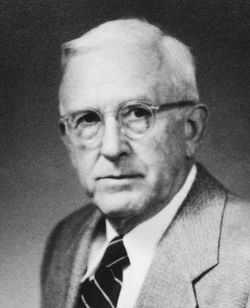Richard Koch
 |  |  |
|---|
Richard Koch is perhaps best known for his work with the Works Progress Administration(WPA), Historic American Buildings Survey (HABS) during the Great Depression. As district officer, Koch led a team of architects in their efforts to document endangered historic buildings in Louisiana with drawings, plans, and photographs. A leader in the establishment of the Vieux Carre Commission and the Arts and Crafts Club of New Orleans, Koch was also a dominant figure in the civic and cultural life of New Orleans, particularly during the 1920s and 1930s. His work promoted scholarly research, cultural enhancement, and civic development in ways entirely unforeseen at the time.
Koch was born June 9, 1889, in New Orleans, son to Anna Frotscher and Julius Koch. In 1910 Koch graduated from Tulane University with a degree in architecture and continued his studies in Paris for two years at the Atelier Bernier. He then worked in several northeastern firms before returning, in 1916, to New Orleans and forming a partnership with Charles Armstrong, whom he had studied with in Paris. Together, they became the city's first practitioners of adaptive reuse architecture and paved the way for preservation architecture, in so developing a reputation for historically sensitive design. Some of the work of the firm's early years included Shadows-on-the-Teche, a townhouse in New Iberia, and Oak Alley, a plantation house in Vacherie. Koch designed a new building for Le Petit Theatre du Vieux Carre that blended with its surroundings.
Koch was an accomplished photographer of buildings in the 1930s, taking his large-format Hasselblad camera to record many historical landmarks throughout the city and state for the HABS program. His firm helped fuel awareness of the need for preservation of historic buildings and helped jumpstart the Vieux Carre Commission in New Orleans’ French Quarter.
In 1934, Koch was appointed leader of HABS in Louisiana, where he would later solidify the relationship with Samuel Wilson Jr. The HABS program, created by the National Park Service, documented America’s architectural heritage. Koch’s vast knowledge of historic buildings in Louisiana and a talented team of 19 architects, draftsmen and photographers would embark, for the next seven years, onto the streets of New Orleans, and into rural Louisiana, to document the state’s most valuable and endangered buildings. They would create a list of 150 buildings that were deemed necessary for documentation. The list was created based on categories such as its age, decay, rareness, and archetype. A comprehensive documentation of 63 buildings, with detailed drawings, photographs and written information would be produced before World War II would put a halt to the HABS program. The final portfolios for each building were sent to the Library of Congress, where they were placed in the Prints and Documents Division and are available for public use.
Charles Armstrong parted ways with Koch soon after Koch began his work with HABS. It was then, in 1935, that Samuel Wilson, Jr. joined Koch's firm and together they worked on projects for the WPA in Louisiana and undertook many restorations of some of the most notable historic landmarks, as well as designed many new buildings that were sensitive to their surroundings. In 1955 Wilson became a partner and he and Koch would work together until Koch's death in 1971.
Koch would play a central role in promoting awareness and later spearheading historic preservation in Louisiana. Many of his comprehensive and detailed documentations would continue to aid in the reconstruction, and adaptive-reuse of projects happening today and thus preserving Louisiana's un-rivaled architectural heritage. Some examples are: The Beauregard Keyes House, Madam John’s Legacy, the Hermann-Grima House, Lafitte’s Blacksmith Shop, the Girod (Napoleon) House and the Villa Meilleur (The African-American History Museum). Many of his records and papers are in the Southeastern Architectural Archives at Tulane University.
Suggested Reading
Cullison, William R. “Tulane’s Richard Koch Collection—A Visual Survey of Historic Architecture in the Mississippi Delta.” Louisiana History, 18 (Fall 1977): 453–471.
Dickenson, Russell E., Robert Broshar, and Daniel J. Boorstin. Foreword to Alicia Stamm and C. Ford Peatross (eds.), Historic America: Buildings, Structures and Sites, Washington, DC: Library of Congress, 1983.
McCollam, Julie H. “The Louisiana HABS Catalog.” In Jessie Poesch and Barbara SoRelle Bacot (eds.), Louisiana Buildings, 1720–1940: The Historic American Buildings Survey, Baton Rouge: Louisiana State University, 1997.
Peterson, Charles E., FAIA, “The Historic American Buildings Survey: Its Beginnings.” In Alicia Stamm and C. Ford Peatross (eds.), Historic America: Buildings, Structures and Sites, Washington, DC: Library of Congress, 1983.
Pierson, William H., Jr. The Colonial and Neoclassical Styles. London: Oxford University Press, 1986.
McCollam, Julie H. “Richard Koch,” in KnowLA Encyclopedia of Louisiana, edited by David Johnson (Louisiana Endowment for the Humanities, 2010–). Article published January 31, 2011.
Frank Masson, “Richard Koch,” in The New Encyclopedia of Southern Culture, Volume 21: Art and Architecture (Chapel Hill: University of North Carolina Press, 2013), 359.
Abbye Gorin, ed. Conversations with Samuel Wilson, Jr., Dean of Architectural Preservation in New Orleans (New Orleans: Louisiana Landmarks Society), 10.
McCollam, “Richard Koch.”
Robert Cangelosi, “Samuel Wilson Jr.,” in KnowLA Encyclopedia of Louisiana, edited by David Johnson (Louisiana Endowment for the Humanities, 2010–). Article published January 25, 2011.